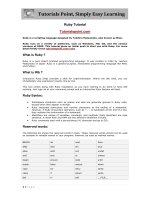assembly tutorial english ebook
Bạn đang xem bản rút gọn của tài liệu. Xem và tải ngay bản đầy đủ của tài liệu tại đây (2.03 MB, 81 trang )
Assembly Language Tutorial
i
ASSEMBLY LANGUAGE TUTORIAL
Simply Easy Learning by tutorialspoint.com
tutorialspoint.com
TUTORIALS POINT
Simply Easy Learning
ABOUT THE TUTORIAL
Assembly Programming Tutorial
Assembly language is a low-level programming language for a computer, or other
programmable device specific to a particular computer architecture in contrast to most high-
level programming languages, which are generally portable across multiple systems.
Assembly language is converted into executable machine code by a utility program referred to
as an assembler like NASM, MASM etc.
Audience
This tutorial has been designed for software programmers with a need to understand the
Assembly programming language starting from scratch. This tutorial will give you enough
understanding on Assembly programming language from where you can take yourself at
higher level of expertise.
Prerequisites
Before proceeding with this tutorial you should have a basic understanding of Computer
Programming terminologies. A basic understanding of any of the programming languages will
help you in understanding the Assembly programming concepts and move fast on the learning
track.
TUTORIALS POINT
Simply Easy Learning
Copyright & Disclaimer Notice
All the content and graphics on this tutorial are the property of tutorialspoint.com. Any content from
tutorialspoint.com or this tutorial may not be redistributed or reproduced in any way, shape, or form
without the written permission of tutorialspoint.com. Failure to do so is a violation of copyright laws.
This tutorial may contain inaccuracies or errors and tutorialspoint provides no guarantee regarding the
accuracy of the site or its contents including this tutorial. If you discover that the tutorialspoint.com site
or this tutorial content contains some errors, please contact us at
TUTORIALS POINT
Simply Easy Learning
Table of Content
Assembly Programming Tutorial 2
Audience 2
Prerequisites 2
Copyright & Disclaimer Notice 3
Assembly Introduction 8
What is Assembly Language? 8
Advantages of Assembly Language 8
Basic Features of PC Hardware 9
The Binary Number System 9
The Hexadecimal Number System 9
Binary Arithmetic 10
Addressing Data in Memory 11
Assembly Environment Setup 13
Installing NASM 13
Assembly Basic Syntax 15
The data Section 15
The bss Section 15
The text section 15
Comments 15
Assembly Language Statements 16
Syntax of Assembly Language Statements 16
The Hello World Program in Assembly 16
Compiling and Linking an Assembly Program in NASM 17
Assembly Memory Segments 18
Memory Segments 18
Assembly Registers 20
Processor Registers 20
Data Registers 20
Pointer Registers 21
Index Registers 21
Control Registers 22
Segment Registers 22
Example: 23
Assembly System Calls 24
Linux System Calls 24
Example 25
Addressing Modes 27
TUTORIALS POINT
Simply Easy Learning
Register Addressing 27
Immediate Addressing 27
Direct Memory Addressing 28
Direct-Offset Addressing 28
Indirect Memory Addressing 28
The MOV Instruction 28
SYNTAX: 28
EXAMPLE: 29
Assembly Variables 31
Allocating Storage Space for Initialized Data 31
Allocating Storage Space for Uninitialized Data 32
Multiple Definitions 32
Multiple Initializations 33
Assembly Constants 34
The EQU Directive 34
Example: 34
The %assign Directive 35
The %define Directive 35
Arithmetic Instructions 37
SYNTAX: 37
EXAMPLE: 37
The DEC Instruction 37
SYNTAX: 37
EXAMPLE: 37
The ADD and SUB Instructions 38
SYNTAX: 38
EXAMPLE: 38
The MUL/IMUL Instruction 40
SYNTAX: 40
EXAMPLE: 41
EXAMPLE: 41
The DIV/IDIV Instructions 42
SYNTAX: 42
EXAMPLE: 43
Logical Instructions 45
The AND Instruction 45
Example: 46
The OR Instruction 46
Example: 47
TUTORIALS POINT
Simply Easy Learning
The XOR Instruction 47
The TEST Instruction 48
The NOT Instruction 48
Assembly Conditions 49
The CMP Instruction 49
SYNTAX 49
EXAMPLE: 49
Unconditional Jump 50
SYNTAX: 50
EXAMPLE: 50
Conditional Jump 50
Example: 51
Assembly Loops 53
Example: 53
Assembly Numbers 55
ASCII Representation 56
BCD Representation 57
Example: 57
Assembly Strings 59
String Instructions 59
MOVS 60
LODS 61
CMPS 62
SCAS 63
Repetition Prefixes 64
Assembly Arrays 65
Example: 66
Assembly Procedures 67
Syntax: 67
Example: 67
Stacks Data Structure: 68
EXAMPLE: 69
Assembly Recursion 70
Assembly Macros 72
Example: 73
Assembly File Management 74
File Descriptor 74
File Pointer 74
File Handling System Calls 74
TUTORIALS POINT
Simply Easy Learning
Creating and Opening a File 75
Opening an Existing File 75
Reading from a File 75
Writing to a File 76
Closing a File 76
Updating a File 76
Example: 77
Memory Management 79
Example: 79
TUTORIALS POINT
Simply Easy Learning
Assembly Introduction
What is Assembly Language?
E
ach personal computer has a microprocessor that manages the computer's arithmetical, logical and
control activities.
Each family of processors has its own set of instructions for handling various operations like getting input from
keyboard, displaying information on screen and performing various other jobs. These set of instructions are called
'machine language instruction'.
Processor understands only machine language instructions which are strings of 1s and 0s. However machine
language is too obscure and complex for using in software development. So the low level assembly language is
designed for a specific family of processors that represents various instructions in symbolic code and a more
understandable form.
Advantages of Assembly Language
An understanding of assembly language provides knowledge of:
Interface of programs with OS, processor and BIOS;
Representation of data in memory and other external devices;
How processor accesses and executes instruction;
How instructions accesses and process data;
How a program access external devices.
Other advantages of using assembly language are:
It requires less memory and execution time;
It allows hardware-specific complex jobs in an easier way;
It is suitable for time-critical jobs;
CHAPTER
1
TUTORIALS POINT
Simply Easy Learning
It is most suitable for writing interrupt service routines and other memory resident programs.
Basic Features of PC Hardware
The main internal hardware of a PC consists of the processor, memory and the registers. The registers are
processor components that hold data and address. To execute a program the system copies it from the external
device into the internal memory. The processor executes the program instructions.
The fundamental unit of computer storage is a bit; it could be on (1) or off (0). A group of nine related bits makes a
byte. Eight bits are used for data and the last one is used for parity. According to the rule of parity, number of bits
that are on (1) in each byte should always be odd.
So the parity bit is used to make the number of bits in a byte odd. If the parity is even, the system assumes that
there had been a parity error (though rare) which might have caused due to hardware fault or electrical
disturbance.
The processor supports the following data sizes:
Word: a 2-byte data item
Doubleword: a 4-byte (32 bit) data item
Quadword: an 8-byte (64 bit) data item
Paragraph: a 16-byte (128 bit) area
Kilobyte: 1024 bytes
Megabyte: 1,048,576 bytes
The Binary Number System
Every number system uses positional notation i.e., each position in which a digit is written has a different
positional value. Each position is power of the base, which is 2 for binary number system, and these powers begin
at 0 and increase by 1.
The following table shows the positional values for an 8-bit binary number, where all bits are set on.
Bit value
1
1
1
1
1
1
1
1
Position value as a
power of base 2
128
64
32
16
8
4
2
1
Bit number
7
6
5
4
3
2
1
0
The value of a binary number is based on the presence of 1 bits and their positional value. So the value of the
given binary number is: 1 + 2 + 4 + 8 +16 + 32 + 64 + 128 = 255, which is same as 2
8
- 1.
The Hexadecimal Number System
Hexadecimal number system uses base 16. The digits range from 0 to 15. By convention, the letters A through F
is used to represent the hexadecimal digits corresponding to decimal values 10 through 15.
TUTORIALS POINT
Simply Easy Learning
Main use of hexadecimal numbers in computing is for abbreviating lengthy binary representations. Basically
hexadecimal number system represents a binary data by dividing each byte in half and expressing the value of
each half-byte. The following table provides the decimal, binary and hexadecimal equivalents:
Decimal number
Binary representation
Hexadecimal representation
0
0
0
1
1
1
2
10
2
3
11
3
4
100
4
5
101
5
6
110
6
7
111
7
8
1000
8
9
1001
9
10
1010
A
11
1011
B
12
1100
C
13
1101
D
14
1110
E
15
1111
F
To convert a binary number to its hexadecimal equivalent, break it into groups of 4 consecutive groups each,
starting from the right, and write those groups over the corresponding digits of the hexadecimal number.
Example: Binary number 1000 1100 1101 0001 is equivalent to hexadecimal - 8CD1
To convert a hexadecimal number to binary just write each hexadecimal digit into its 4-digit binary equivalent.
Example: Hexadecimal number FAD8 is equivalent to binary - 1111 1010 1101 1000
Binary Arithmetic
The following table illustrates four simple rules for binary addition:
(i)
(ii)
(iii)
(iv)
1
0
1
1
1
+0
+0
+1
+1
=0
=1
=10
=11
Rules (iii) and (iv) shows a carry of a 1-bit into the next left position.
Example:
TUTORIALS POINT
Simply Easy Learning
Decimal
Binary
60
00111100
+42
00101010
102
01100110
A negative binary value is expressed in two's complement notation. According to this rule, to convert a binary
number to its negative value is to reverse its bit values and add 1.
Example:
Number 53
00110101
Reverse the bits
11001010
Add 1
1
Number -53
11001011
To subtract one value from another, convert the number being subtracted to two's complement format and add
the numbers.
Example: Subtract 42 from 53
Number 53
00110101
Number 42
00101010
Reverse the bits of 42
11010101
Add 1
1
Number -42
11010110
53 - 42 = 11
00001011
Overflow of the last 1 bit is lost.
Addressing Data in Memory
The process through which the processor controls the execution of instructions is referred as the fetch-decode-
execute cycle, or the execution cycle. It consists of three continuous steps:
Fetching the instruction from memory
Decoding or identifying the instruction
Executing the instruction
The processor may access one or more bytes of memory at a time. Let us consider a hexadecimal number
0725H. This number will require two bytes of memory. The high-order byte or most significant byte is 07 and the
low order byte is 25.
The processor stores data in reverse-byte sequence i.e., the low-order byte is stored in low memory address and
high-order byte in high memory address. So if processor brings the value 0725H from register to memory, it will
transfer 25 first to the lower memory address and 07 to the next memory address.
TUTORIALS POINT
Simply Easy Learning
x: memory address
When the processor gets the numeric data from memory to register, it again reverses the bytes. There are two
kinds of memory addresses:
An absolute address - a direct reference of specific location.
The segment address (or offset) - starting address of a memory segment with the offset value
TUTORIALS POINT
Simply Easy Learning
Assembly Environment Setup
A
ssembly language is dependent upon the instruction set and the architecture of the processor. In this
tutorial, we focus on Intel 32 processors like Pentium. To follow this tutorial, you will need:
An IBM PC or any equivalent compatible computer
A copy of Linux operating system
A copy of NASM assembler program
There are many good assembler programs, like:
Microsoft Assembler (MASM)
Borland Turbo Assembler (TASM)
The GNU assembler (GAS)
We will use the NASM assembler, as it is:
Free. You can download it from various web sources.
Well documented and you will get lots of information on net.
Could be used on both Linux and Windows
Installing NASM
If you select "Development Tools" while installed Linux, you may NASM installed along with the Linux operating
system and you do not need to download and install it separately. For checking whether you already have NASM
installed, take the following steps:
Open a Linux terminal.
Type whereis nasm and press ENTER.
If it is already installed then a line like, nasm: /usr/bin/nasm appears. Otherwise, you will see justnasm:, then
you need to install NASM.
To install NASM take the following steps:
CHAPTER
2
TUTORIALS POINT
Simply Easy Learning
Check The netwide assembler (NASM) website for the latest version.
Download the Linux source archive nasm-X.XX. ta .gz, where X.XX is the NASM version number in the
archive.
Unpack the archive into a directory, which creates a subdirectory nasm-X. XX.
cd to nasm-X. XX and type ./configure . This shell script will find the best C compiler to use and set up
Makefiles accordingly.
Type make to build the nasm and ndisasm binaries.
Type make install to install nasm and ndisasm in /usr/local/bin and to install the man pages.
This should install NASM on your system. Alternatively, you can use an RPM distribution for the Fedora Linux.
This version is simpler to install, just double-click the RPM file.
TUTORIALS POINT
Simply Easy Learning
Assembly Basic Syntax
A
n assembly program can be divided into three sections:
The data section
The bss section
The text section
The data Section
The data section is used for declaring initialized data or constants. This data does not change at runtime. You
can declare various constant values, file names or buffer size etc. in this section.
The syntax for declaring data section is:
section .data
The bss Section
The bss section is used for declaring variables. The syntax for declaring bss section is:
section .bss
The text section
The text section is used for keeping the actual code. This section must begin with the declarationglobal main,
which tells the kernel where the program execution begins.
The syntax for declaring text section is:
section .text
global main
main:
Comments
Assembly language comment begins with a semicolon (;). It may contain any printable character including blank.
It can appear on a line by itself, like:
CHAPTER
3
TUTORIALS POINT
Simply Easy Learning
; This program displays a message on screen
or, on the same line along with an instruction, like:
add eax ,ebx ; adds ebx to eax
Assembly Language Statements
Assembly language programs consist of three types of statements:
Executable instructions or instructions
Assembler directives or pseudo-ops
Macros
The executable instructions or simply instructions tell the processor what to do. Each instruction consists of
an operation code (opcode). Each executable instruction generates one machine language instruction.
The assembler directives or pseudo-ops tell the assembler about the various aspects of the assembly process.
These are non-executable and do not generate machine language instructions.
Macros are basically a text substitution mechanism.
Syntax of Assembly Language Statements
Assembly language statements are entered one statement per line. Each statement follows the following format:
[label] mnemonic [operands] [;comment]
The fields in the square brackets are optional. A basic instruction has two parts, the first one is the name of the
instruction (or the mnemonic) which is to be executed, and the second are the operands or the parameters of the
command.
Following are some examples of typical assembly language statements:
INC COUNT ; Increment the memory variable COUNT
MOV TOTAL, 48 ; Transfer the value 48 in the
; memory variable TOTAL
ADD AH, BH ; Add the content of the
; BH register into the AH register
AND MASK1, 128 ; Perform AND operation on the
; variable MASK1 and 128
ADD MARKS, 10 ; Add 10 to the variable MARKS
MOV AL, 10 ; Transfer the value 10 to the AL register
The Hello World Program in Assembly
The following assembly language code displays the string 'Hello World' on the screen:
section .text
global main ;must be declared for linker (ld)
main: ;tells linker entry point
mov edx,len ;message length
mov ecx,msg ;message to write
mov ebx,1 ;file descriptor (stdout)
mov eax,4 ;system call number (sys_write)
int 0x80 ;call kernel
TUTORIALS POINT
Simply Easy Learning
mov eax,1 ;system call number (sys_exit)
int 0x80 ;call kernel
section .data
msg db 'Hello, world!', 0xa ;our dear string
len equ $ - msg ;length of our dear string
When the above code is compiled and executed, it produces following result:
Hello, world!
Compiling and Linking an Assembly Program in NASM
Make sure you have set the path of nasm and ld binaries in your PATH environment variable. Now take the
following steps for compiling and linking the above program:
Type the above code using a text editor and save it as hello.asm.
Make sure that you are in the same directory as where you saved hello.asm.
To assemble the program, type nasm -f elf hello.asm
If there is any error, you will be prompted about that at this stage. Otherwise an object file of your program
named hello.o will be created.
To link the object file and create an executable file named hello, type ld -m elf_i386 -s -o hello hello.o
Execute the program by typing ./hello
If you have done everything correctly, it will display Hello, world! on the screen.
TUTORIALS POINT
Simply Easy Learning
Assembly Memory Segments
W
e have already discussed three sections of an assembly program. These sections represent various
memory segments as well.
Interestingly, if you replace the section keyword with segment, you will get the same result. Try the following code:
segment .text ;code segment
global main ;must be declared for linker
main: ;tell linker entry point
mov edx,len ;message length
mov ecx,msg ;message to write
mov ebx,1 ;file descriptor (stdout)
mov eax,4 ;system call number (sys_write)
int 0x80 ;call kernel
mov eax,1 ;system call number (sys_exit)
int 0x80 ;call kernel
segment .data ;data segment
msg db Hello, world!',0xa ;our dear string
len equ $ - msg ;length of our dear string
When the above code is compiled and executed, it produces following result:
Hello, world!
Memory Segments
A segmented memory model divides the system memory into groups of independent segments, referenced by
pointers located in the segment registers. Each segment is used to contain a specific type of data. One segment
is used to contain instruction codes, another segment stores the data elements, and a third segment keeps the
program stack.
In the light of the above discussion, we can specify various memory segments as:
Data segment - it is represented by .data section and the .bss. The .data section is used to declare the
memory region where data elements are stored for the program. This section cannot be expanded after the
data elements are declared, and it remains static throughout the program.
The .bss section is also a static memory section that contains buffers for data to be declared later in the
program. This buffer memory is zero-filled.
CHAPTER
4
TUTORIALS POINT
Simply Easy Learning
Code segment - it is represented by .text section. This defines an area in memory that stores the instruction
codes. This is also a fixed area.
Stack - this segment contains data values passed to functions and procedures within the program.
TUTORIALS POINT
Simply Easy Learning
Assembly Registers
P
rocessor operations mostly involve processing data. This data can be stored in memory and accessed
from thereon. However, reading data from and storing data into memory slows down the processor, as it involves
complicated processes of sending the data request across the control bus, and into the memory storage unit and
getting the data through the same channel.
To speed up the processor operations, the processor includes some internal memory storage locations,
called registers.
The registers stores data elements for processing without having to access the memory. A limited number of
registers are built into the processor chip.
Processor Registers
There are ten 32-bit and six 16-bit processor registers in IA-32 architecture. The registers are grouped into three
categories:
General registers
Control registers
Segment registers
The general registers are further divided into the following groups:
Data registers
Pointer registers
Index registers
Data Registers
Four 32-bit data registers are used for arithmetic, logical and other operations. These 32-bit registers can be used
in three ways:
1. As complete 32-bit data registers: EAX, EBX, ECX, EDX.
CHAPTER
5
TUTORIALS POINT
Simply Easy Learning
2. Lower halves of the 32-bit registers can be used as four 16-bit data registers: AX, BX, CX and DX.
3. Lower and higher halves of the above-mentioned four 16-bit registers can be used as eight 8-bit data
registers: AH, AL, BH, BL, CH, CL, DH, and DL.
Some of these data registers has specific used in arithmetical operations.
AX is the primary accumulator; it is used in input/output and most arithmetic instructions. For example, in
multiplication operation, one operand is stored in EAX, or AX or AL register according to the size of the operand.
BX is known as the base register as it could be used in indexed addressing.
CX is known as the count register as the ECX, CX registers store the loop count in iterative operations.
DX is known as the data register. It is also used in input/output operations. It is also used with AX register along
with DX for multiply and divide operations involving large values.
Pointer Registers
The pointer registers are 32-bit EIP, ESP and EBP registers and corresponding 16-bit right portions � IP, SP and
BP. There are three categories of pointer registers:
Instruction Pointer (IP) - the 16-bit IP register stores the offset address of the next instruction to be
executed. IP in association with the CS register (as CS:IP) gives the complete address of the current
instruction in the code segment.
Stack Pointer (SP) - the 16-bit SP register provides the offset value within the program stack. SP in
association with the SS register (SS:SP) refers to be current position of data or address within the program
stack.
Base Pointer (BP) - the 16-bit BP register mainly helps in referencing the parameter variables passed to a
subroutine. The address in SS register is combined with the offset in BP to get the location of the parameter.
BP can also be combined with DI and SI as base register for special addressing.
Index Registers
The 32-bit index registers ESI and EDI and their 16-bit rightmost portions SI and DI are used for indexed
addressing and sometimes used in addition and subtraction. There are two sets of index pointers:
Source Index (SI) - it is used as source index for string operations
Destination Index (DI) - it is used as destination index for string operations.
TUTORIALS POINT
Simply Easy Learning
Control Registers
The 32-bit instruction pointer register and 32-bit flags register combined are considered as the control registers.
Many instructions involve comparisons and mathematical calculations and change the status of the flags and
some other conditional instructions test the value of these status flags to take the control flow to other location.
The common flag bits are:
Overflow Flag (OF): indicates the overflow of a high-order bit (leftmost bit) of data after a signed arithmetic
operation.
Direction Flag (DF): determines left or right direction for moving or comparing string data. When the DF
value is 0, the string operation takes left-to-right direction and when the value is set to 1, the string operation
takes right-to-left direction.
Interrupt Flag (IF): determines whether the external interrupts like, keyboard entry etc. are to be ignored or
processed. It disables the external interrupt when the value is 0 and enables interrupts when set to 1.
Trap Flag (TF): allows setting the operation of the processor in single-step mode. The DEBUG program we
used sets the trap flag, so we could step through the execution one instruction at a time.
Sign Flag (SF): shows the sign of the result of an arithmetic operation. This flag is set according to the sign
of a data item following the arithmetic operation. The sign is indicated by the high-order of leftmost bit. A
positive result clears the value of SF to 0 and negative result sets it to 1.
Zero Flag (ZF): indicates the result of an arithmetic or comparison operation. A nonzero result clears the
zero flag to 0, and a zero result sets it to 1.
Auxiliary Carry Flag (AF): contains the carry from bit 3 to bit 4 following an arithmetic operation; used for
specialized arithmetic. The AF is set when a 1-byte arithmetic operation causes a carry from bit 3 into bit 4.
Parity Flag (PF): indicates the total number of 1-bits in the result obtained from an arithmetic operation. An
even number of 1-bits clears the parity flag to 0 and an odd number of 1-bits sets the parity flag to 1.
Carry Flag (CF): contains the carry of 0 or 1 from a high-order bit (leftmost) after an arithmetic operation. It
also stores the contents of last bit of a shift or rotate operation.
The following table indicates the position of flag bits in the 16-bit Flags register:
Flag:
O
D
I
T
S
Z
A
P
C
Bit no:
15
14
13
12
11
10
9
8
7
6
5
4
3
2
1
0
Segment Registers
Segments are specific areas defined in a program for containing data, code and stack. There are three main
segments:
Code Segment: it contains all the instructions to be executed. A 16 - bit Code Segment register or CS
register stores the starting address of the code segment.
Data Segment: it contains data, constants and work areas. A 16 - bit Data Segment register of DS register
stores the starting address of the data segment.
Stack Segment: it contains data and return addresses of procedures or subroutines. It is implemented as a
'stack' data structure. The Stack Segment register or SS register stores the starting address of the stack.
TUTORIALS POINT
Simply Easy Learning
Apart from the DS, CS and SS registers, there are other extra segment registers - ES (extra segment), FS and
GS, which provides additional segments for storing data.
In assembly programming, a program needs to access the memory locations. All memory locations within a
segment are relative to the starting address of the segment. A segment begins in an address evenly disable by 16
or hexadecimal 10. So all the rightmost hex digit in all such memory addresses is 0, which is not generally stored
in the segment registers.
The segment registers stores the starting addresses of a segment. To get the exact location of data or instruction
within a segment, an offset value (or displacement) is required. To reference any memory location in a segment,
the processor combines the segment address in the segment register with the offset value of the location.
Example:
Look at the following simple program to understand the use of registers in assembly programming. This program
displays 9 stars on the screen along with a simple message:
section .text
global main ;must be declared for linker (gcc)
main: ;tell linker entry point
mov edx,len ;message length
mov ecx,msg ;message to write
mov ebx,1 ;file descriptor (stdout)
mov eax,4 ;system call number (sys_write)
int 0x80 ;call kernel
mov edx,9 ;message length
mov ecx,s2 ;message to write
mov ebx,1 ;file descriptor (stdout)
mov eax,4 ;system call number (sys_write)
int 0x80 ;call kernel
mov eax,1 ;system call number (sys_exit)
int 0x80 ;call kernel
section .data
msg db 'Displaying 9 stars',0xa ;a message
len equ $ - msg ;length of message
s2 times 9 db '*'
When the above code is compiled and executed, it produces following result:
Displaying 9 stars
*********
TUTORIALS POINT
Simply Easy Learning
Assembly System Calls
S
ystem calls are APIs for the interface between user space and kernel space. We have already used the
system calls sys_write and sys_exit for writing into the screen and exiting from the program respectively.
Linux System Calls
You can make use of Linux system calls in your assembly programs. You need to take the following steps for
using Linux system calls in your program:
Put the system call number in the EAX register.
Store the arguments to the system call in the registers EBX, ECX, etc.
Call the relevant interrupt (80h)
The result is usually returned in the EAX register
There are six registers that stores the arguments of the system call used. These are the EBX, ECX, EDX, ESI,
EDI, and EBP. These registers take the consecutive arguments, starting with the EBX register. If there are more
than six arguments then the memory location of the first argument is stored in the EBX register.
The following code snippet shows the use of the system call sys_exit:
mov eax,1 ; system call number (sys_exit)
int 0x80 ; call kernel
The following code snippet shows the use of the system call sys_write:
mov edx,4 ; message length
mov ecx,msg ; message to write
mov ebx,1 ; file descriptor (stdout)
mov eax,4 ; system call number (sys_write)
int 0x80 ; call kernel
All the syscalls are listed in /usr/include/asm/unistd.h, together with their numbers (the value to put in EAX before
you call int 80h).
The following table shows some of the system calls used in this tutorial:
CHAPTER
6









